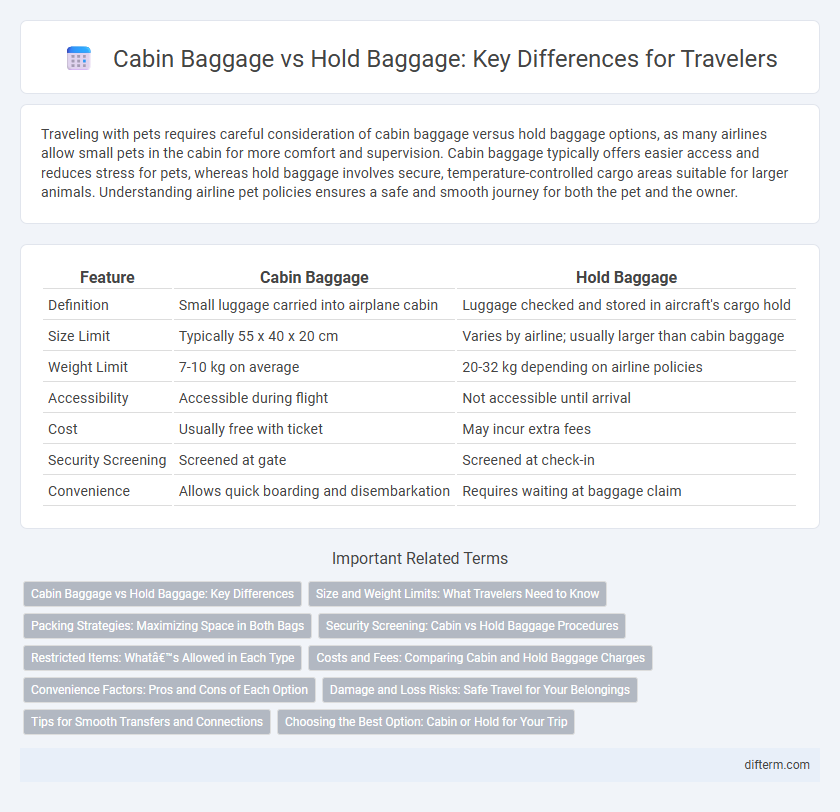Traveling with pets requires careful consideration of cabin baggage versus hold baggage options, as many airlines allow small pets in the cabin for more comfort and supervision. Cabin baggage typically offers easier access and reduces stress for pets, whereas hold baggage involves secure, temperature-controlled cargo areas suitable for larger animals. Understanding airline pet policies ensures a safe and smooth journey for both the pet and the owner.
Table of Comparison
| Feature | Cabin Baggage | Hold Baggage |
|---|---|---|
| Definition | Small luggage carried into airplane cabin | Luggage checked and stored in aircraft's cargo hold |
| Size Limit | Typically 55 x 40 x 20 cm | Varies by airline; usually larger than cabin baggage |
| Weight Limit | 7-10 kg on average | 20-32 kg depending on airline policies |
| Accessibility | Accessible during flight | Not accessible until arrival |
| Cost | Usually free with ticket | May incur extra fees |
| Security Screening | Screened at gate | Screened at check-in |
| Convenience | Allows quick boarding and disembarkation | Requires waiting at baggage claim |
Cabin Baggage vs Hold Baggage: Key Differences
Cabin baggage refers to luggage passengers are allowed to carry into the airplane cabin, typically limited by size and weight restrictions set by airlines, ensuring convenience and quick access during the flight. Hold baggage, stored in the aircraft's cargo hold, accommodates larger and heavier items but requires check-in and complies with strict security regulations. Understanding these differences helps travelers optimize packing, avoid extra fees, and streamline their airport experience.
Size and Weight Limits: What Travelers Need to Know
Cabin baggage typically must comply with size limits of around 55 x 40 x 20 cm and weight restrictions ranging from 7 to 10 kg, ensuring it fits in overhead compartments or under the seat. Hold baggage allowances vary significantly between airlines but generally allow larger dimensions and heavier weight, often up to 23 kg per bag for economy class passengers. Understanding these size and weight limits helps travelers avoid extra fees and ensures a smooth boarding experience.
Packing Strategies: Maximizing Space in Both Bags
Optimizing space in cabin and hold baggage requires strategic packing techniques such as rolling clothes to minimize wrinkles and using vacuum-seal bags or packing cubes to compress items efficiently. Prioritize essential and fragile items in cabin baggage for easy access while loading bulkier, less frequently needed items in hold baggage to balance weight and volume. Distributing weight evenly and utilizing every available compartment ensures maximum capacity without exceeding airline restrictions.
Security Screening: Cabin vs Hold Baggage Procedures
Security screening procedures for cabin baggage involve thorough manual and X-ray inspections to ensure prohibited items are not brought on board, with passengers required to remove liquids and electronic devices for separate screening. Hold baggage undergoes advanced, automated scanning and explosive detection systems, enabling comprehensive examination without passenger involvement. These stringent security measures prioritize passenger safety while streamlining the boarding process.
Restricted Items: What’s Allowed in Each Type
Cabin baggage allows passengers to carry essentials such as electronics, medications, and limited liquids under 100ml, but sharp objects and large liquids are restricted. Hold baggage permits larger quantities of liquids, sharp items, and sports equipment, provided they meet airline safety regulations and weight limits. Passengers must review specific airline policies to avoid prohibited items in both cabin and hold luggage, ensuring smooth security checks.
Costs and Fees: Comparing Cabin and Hold Baggage Charges
Cabin baggage typically incurs lower or no additional fees compared to hold baggage, which often carries higher charges depending on the airline and flight route. Airlines usually allow one free cabin bag under specific size and weight limits, while hold baggage fees vary based on weight, dimensions, and number of checked bags. Understanding cost differences between cabin and hold baggage can help travelers minimize expenses during flight booking and check-in.
Convenience Factors: Pros and Cons of Each Option
Cabin baggage offers the convenience of quick access to personal items during the flight and avoids waiting at baggage claim but is limited by strict size and weight restrictions. Hold baggage allows for larger and heavier items without size constraints, ensuring less hassle carrying load through the airport, yet it requires advance check-in and potential waiting time upon arrival. Choosing between cabin and hold baggage depends on travel duration, airline policies, and personal preferences for mobility versus capacity.
Damage and Loss Risks: Safe Travel for Your Belongings
Cabin baggage reduces the risk of loss and damage since it remains with the traveler throughout the journey, providing constant supervision and protection. Hold baggage is more susceptible to rough handling, misplacement, or theft due to its storage in the aircraft's cargo hold and multiple transfers during transit. Choosing cabin baggage for fragile and valuable items enhances safe travel, minimizing damage and loss risks.
Tips for Smooth Transfers and Connections
Cabin baggage offers quick access to essentials during flight connections, reducing wait times at luggage carousels and minimizing the risk of lost bags. Hold baggage requires early check-in and careful timing to ensure it is transferred to connecting flights without delays, especially during tight layovers or busy airports. Opt for lightweight, easily accessible cabin bags and confirm hold baggage policies in advance to facilitate seamless transfer experiences.
Choosing the Best Option: Cabin or Hold for Your Trip
Selecting the right baggage type depends on your trip duration, airline regulations, and personal convenience. Cabin baggage offers quick access to essentials and avoids check-in delays, while hold baggage accommodates larger items and excess weight. Weighing the importance of speed versus capacity ensures a smooth travel experience tailored to your needs.
cabin baggage vs hold baggage Infographic

 difterm.com
difterm.com